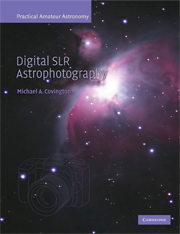Book contents
- Frontmatter
- Contents
- Preface
- Part I Basics
- Part II Cameras, lenses, and telescopes
- 5 Coupling cameras to telescopes
- 6 More about focal reducers
- 7 Lenses for piggybacking
- 8 Focusing
- 9 Tracking the stars
- 10 Power and camera control in the field
- 11 Sensors and sensor performance
- Part III Digital image processing
- Part IV Appendices
- Index
6 - More about focal reducers
Published online by Cambridge University Press: 21 August 2009
- Frontmatter
- Contents
- Preface
- Part I Basics
- Part II Cameras, lenses, and telescopes
- 5 Coupling cameras to telescopes
- 6 More about focal reducers
- 7 Lenses for piggybacking
- 8 Focusing
- 9 Tracking the stars
- 10 Power and camera control in the field
- 11 Sensors and sensor performance
- Part III Digital image processing
- Part IV Appendices
- Index
Summary
Focal reducers are invaluable for deep-sky work with DSLRs because they make the image smaller and brighter. Since the DSLR sensor is smaller than 35-mm film, you can switch from film to a DSLR, add a focal reducer, and cover the same field with a brighter image.
The most popular Meade and Celestron focal reducers multiply the focal length and f-ratio by 0.63 (giving f/6.3 with an f/10 telescope). That's a handy reduction factor because it shrinks an image from the size of 35-mm film to the size of an APS-C sensor. What's more, the image comes out (1/0.63)2 = 2.52 times as bright, cutting the exposure time to 40% of what it would have been.
But focal reducers are sadly misunderstood, and they don't always work the way the users expect. In what follows, I'll try to clear up some misconceptions.
Key concepts
The first thing to understand is that a focal reducer makes the image smaller – it doesn't make the field wider. It doesn't turn your telescope into a wider-field instrument than it was originally.
It's true that the field of view increases when the image becomes smaller, because more of the image fits on the sensor. But that is only true of the image that the telescope captured in the first place. A focal reducer will not make the telescope see things that were outside its field altogether.
That is one reason some vignetting is almost inevitable with a focal reducer.
- Type
- Chapter
- Information
- Digital SLR Astrophotography , pp. 63 - 69Publisher: Cambridge University PressPrint publication year: 2007



